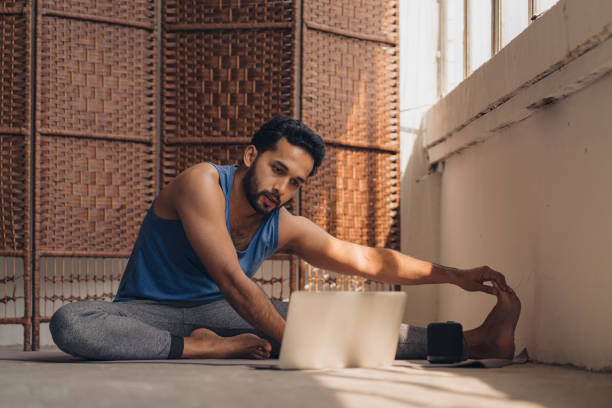Fitness Habits, Fitness Myths, Wellness
How Do You Know If Yoga Is Working For You
Yoga has grown in popularity in recent years, as more individuals seek its physical and mental benefits. However, with so many distinct types of yoga and differing degrees of expertise among practitioners, it can be difficult to determine if yoga is genuinely working for you. In this article, we’ll look at some of the major indications that might help you assess whether your yoga practice is working for you.
One of the most evident evidence that yoga is benefiting you is a boost in your physical health. Regular yoga practice can improve flexibility, strength, and balance, as well as lessen pain and inflammation in the body. If you realize that you can move more easily, that you are less uncomfortable during physical activity, or that your general physical appearance has improved, it is possible that your yoga practice is working.
In addition to physical changes, yoga can have a significant impact on your mental and emotional health. Many people report feeling more calm, centered, and focused after practicing yoga, as well as having lower levels of tension and anxiety. If you notice that you are better able to manage your emotions, feel more grounded and present in the moment, or have a general sense of serenity and contentment, this could be a sign that your yoga practice is assisting you in cultivating a more balanced and harmonious lifestyle.

Recognizing Physical Improvements
When practicing yoga, it is critical to pay attention to your body and observe any changes that may occur. As you continue your yoga practice, you may experience the following bodily improvements:
Increased Flexibility
One of the most visible physical gains that can result from regular yoga practice is increased flexibility. You may notice that you can move more easily into postures that were previously difficult, or that your range of motion has increased. This can be particularly obvious in the hips, hamstrings, and shoulders.
Enhanced Strength
Yoga can also help you gain strength throughout your body. While many people conceive of yoga as a stretching-only activity, many positions need tremendous strength to hold and maintain. Over time, you may discover that you can hold poses for longer periods of time or move more effortlessly into difficult poses.
Improved Balance
Balance is another aspect that can benefit from regular yoga practice. Many yoga positions demand a high level of balance and stability, which can help you improve your general balance over time. You may notice that you can now hold poses that were previously unsteady or unstable, or that you can shift more effortlessly from one pose to another without losing balance.
Steadier Breathing
Finally, yoga can help you breathe more effectively. Many yoga sessions include breathing techniques, or pranayama, that can assist enhance lung capacity and improve general respiratory function. You may notice that you can take deeper, steadier breaths during your yoga practice, or that you can keep a steady breath even during difficult positions.
Overall, these bodily gains can be a good indicator of whether yoga is working for you. While everyone’s experience is unique, paying attention to these areas can help you track your progress and continue to improve your practice.

Monitoring Mental and Emotional Changes
To measure whether yoga is working for you or not, we must watch our mental and emotional responses. Here are some important things to focus on:
Reduced Stress Levels
One of the most important benefits of yoga is its ability to relieve stress. Regular yoga practice may result in a reduction in stress levels as well as an increase in our ability to manage stress. We may also experience more relaxation and peace during the day.
Heightened Mindfulness
Yoga can also help us develop mindfulness. Practicing attention on our breath and body allows us to become more present in the moment. This mindfulness can extend into our daily life, allowing us to be more alert and aware of our thoughts and feelings.
Better Sleep Quality
Another advantage of yoga is better sleep quality. We may be able to sleep deeper and more soundly if we do yoga before bed. We may also find it easier to fall and stay asleep all night.
Enhanced Mood
Yoga can also improve our mood. We may feel happier and more pleased if we release tension and improve our overall well-being. Furthermore, the physical practice of yoga can produce endorphins, which can improve our mood and overall sense of well-being.
To summarize, monitoring our mental and emotional shifts is critical in assessing whether yoga is beneficial to us. By monitoring our stress levels, mindfulness, sleep quality, and mood, we can assess the effectiveness of our yoga practice and make any adjustments.

Assessing Lifestyle Impact
When deciding whether yoga is right for you, we must consider how it affects your lifestyle. Here are some important considerations to consider.
Consistency in Practice
Consistent practice is one of the most significant aspects in assessing whether yoga is beneficial to us. Regular practice increases our chances of reaping the advantages of yoga. To actually see the impact of yoga on our life, we must practice consistently, whether on a daily or weekly basis.
Incorporation into Daily Routine
Another important thing to consider is how effectively we include yoga into our everyday practice. Are we dedicating time to our practice, or are we always skipping sessions? If we can make yoga a regular part of our routine, we are more likely to notice the benefits it has on our life.
Diet and Nutrition Synergy
Finally, analyze how our diet and nutrition choices affect our yoga practice. Are we providing our bodies with the necessary nutrition to support our practice? Are we making healthy choices to supplement our yoga practice? By paying attention to our diet and nutrition practices, we may maximize the benefits of our yoga practice.
In conclusion, evaluating the impact of yoga on our lifestyle is a vital step in establishing whether it is working for us or not. We may get the most of our practice by sticking to a steady schedule, including yoga into our everyday routine, and paying attention to our diet and nutrition practices.

Understanding Long-Term Benefits
Yoga’s benefits extend beyond the physical component. In reality, the long-term advantages of yoga can significantly improve our entire well-being. Let us take a closer look at some of these perks.
Chronic Pain Management
One of the most important advantages of yoga is its capacity to assist manage chronic pain. Yoga can help relieve back pain, joint pain, and muscle pain. By practicing yoga on a regular basis, we can increase our flexibility and muscle strength, lowering the risk of injury and preventing chronic pain from developing.
Longevity of Practice
Another advantage of yoga is its longevity. Unlike other forms of exercise, which may become too rigorous as we age, yoga can be performed until our senior years. As we age, our bodies become less flexible and more prone to injury; however, by practicing yoga on a daily basis, we may retain our flexibility and improve our balance, which can help prevent falls and accidents.
Overall Wellness
Finally, the long-term benefits of yoga go beyond physical wellness. Yoga has been demonstrated to lower stress and anxiety, enhance sleep quality, and increase general well-being. By practicing yoga on a daily basis, we can develop a stronger sense of self-awareness and mindfulness, allowing us to negotiate life’s ups and downs with greater ease and grace.
In conclusion, the long-term benefits of yoga are vast and diverse. By adopting yoga into our everyday practice, we may improve our physical, mental, and overall wellness.

Participation in Yoga Classes
One technique to determine whether yoga is beneficial to us is to measure our participation in yoga classes. Regular yoga courses can help us maintain consistency with our practice and develop a feeling of discipline. Attending classes allows us to receive direction and feedback from our yoga teachers, which can help us develop our practice.
It’s crucial to recognize that simply attending classes may not be sufficient to establish whether yoga is right for us. We should also consider how we feel during and after class. Are we feeling more relaxed, energized, or focused? Are we capable of performing positions with increased comfort and flexibility? All of these factors point to the fact that our yoga practice is beneficial to our health.

Experimenting with Different Styles of Yoga
There are numerous forms of yoga, and it is critical to select one that works best for you. If you’re not getting the results you desire, consider experimenting with other styles to discover which one speaks to you the best. Hatha, Vinyasa, and Bikram are some popular yoga styles.
Adjusting for Personal Goals
It is also critical to modify your practice to match your specific objectives. If you’re doing yoga to relieve stress, you might want to focus on restorative positions and breathing exercises. If you’re doing yoga to improve your flexibility, you might want to focus on more difficult poses and longer holds.
Seeking Professional Guidance
Finally, if you are still not obtaining the desired outcomes, it may be beneficial to seek professional assistance. A yoga instructor or therapist can assist you in identifying areas where your practice may need to be adjusted, as well as providing suggestions on how to proceed.
By experimenting with different techniques, modifying for personal goals, and obtaining professional advice, we may ensure that our yoga practice is beneficial and helps us achieve our objectives.
Conclusion
Finally, assessing if yoga is working for you requires a careful assessment of both your physical and emotional health. Paying attention to changes in flexibility, strength, and overall fitness, as well as mental clarity and emotional balance, can help you understand the success of your yoga practice. Regular self-reflection, listening to your body, and acknowledging the good effects on stress levels and overall happiness all contribute to a comprehensive awareness of whether yoga is working for you. Finally, the goal is to embrace yoga as a personal journey, changing your practice as needed, and recognizing the good changes Yoga brings into your life.
Journey of self discovery


